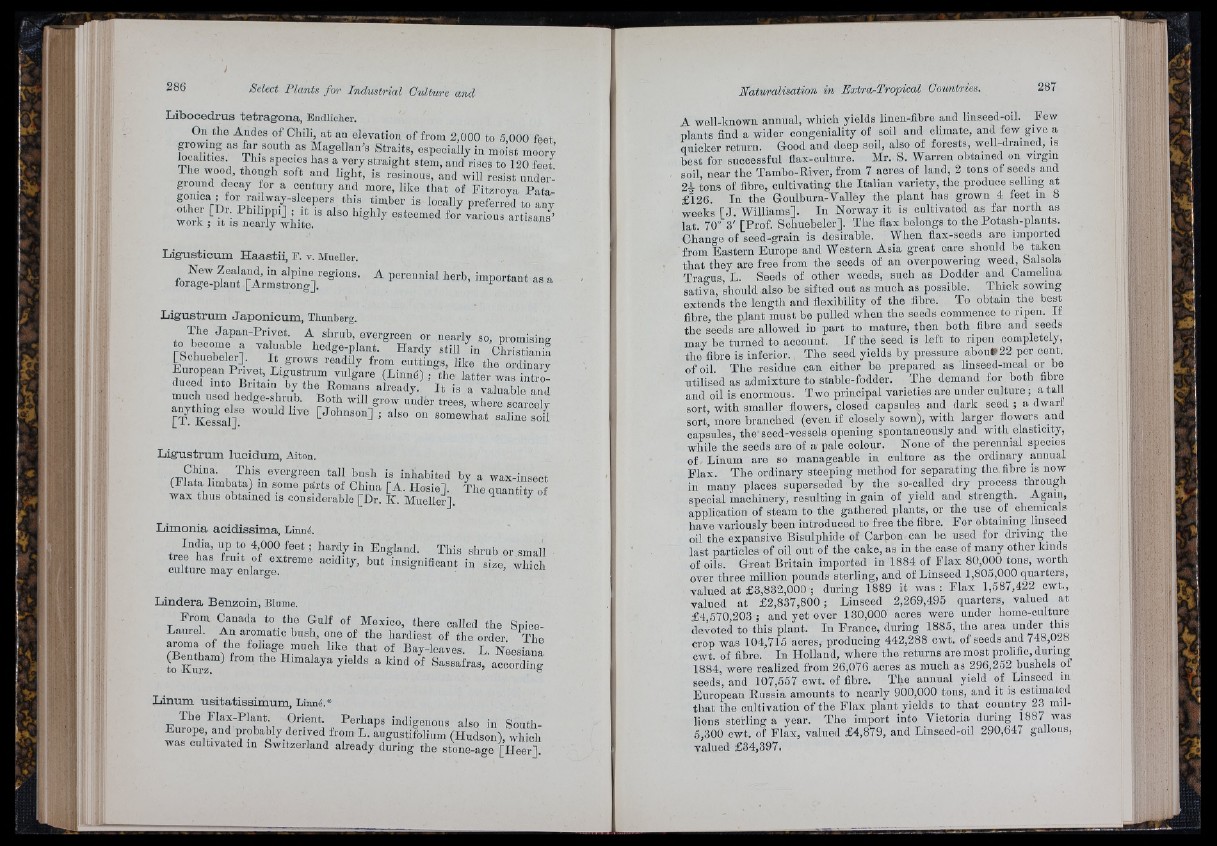
1, Il
I lit.
■ if
frf
286 Select Plants fo r Industrial Culture and
Libooedrus tetragona, Endlicher.
On tlie Andes of Cliili, a t an elevation of from 2,000 to 5 000 feet
f o S s “' Straits, especially in moist moor/
T iE w 2 l J f ®®T I stem, and rises to 120 feet,
ir e T 1 ‘in d will resist underground
decay for a century and more, like tliat of Fitzioya Patawork
; .]* "‘i®o *“ ghly esteemed for work ; It IS nearly white. various artisans^
Ligusticum Haastii, F. v. Mueller.
for“ aL t[A rm sÏo Ê S ."'“ " - ^ "
Ligustrum Japonicum, Thunberg.
Tlie Jap an -Priv et A shrub, evergreen or nearly so, promisiuof
s e l n iT L 1 ß T Iredge-plant. Hardy still in CliristiaiiL
LScliuebeler]. I t grows readily from cuttings, like the ordinary
European Pnvet,_Ligustrum vulgare (LiimCi) ; the latter was introduced
into Britain by the Komaiis already. I t is a valuable and
much used hedge-shrub. Both will grow under trees, wliere scarcely
[T rK e ^ s a t]“ [Johnson] ; also on somewhat saline sod
Ligustrum luoidum, Aiton.
1 Tl'® *‘‘11 l^osh i® inhabited by a wax-inseot
(Flata limbata) in some parts of China [A. Hosie], The quantity of
wax thus obtained is considerable [Dr. K, Mueller],
Limonia aoidissima, Linné,
t r i “f / ’ 7 fr ^’7 ° ß This Shrub or small
: X i r e L l r - l a r g r " ” °
Lindera Benzoin, Blume.
T n o E r Mexico, there called the Spioe-
Laurel. An aromatic bi.sli, one of the hardiest of the order The
aroma of the foliage mucli like that of Bay-leaves. L. Neesiana
to Knr7 Plimalaya yields a kind of Sassafras, according
Linum usitatissimum, Linné.*
E,™® I'lax -P lan t Orient Perhaps indigenous also in South-
Europe and probably derived from L. augustifblium (Hudson) wliieli
was cultivated in Switzerland already during the stone-age [Ile e r].
Naturalisation in Extra-Tropical Countries. 287
A well-known annual, which yields linen-fibre and iinseed-oil. Few
plants find a wider congeniality of soil and climate, and few give a
miicker return. Good aud deep soil, also of forests, well-drained, is
best for successful flax-culture. Mr. S. Warren obtained ou virgin
soil, near the Tambo-River, from 7 acres of land, 2 tons of seeds and
2L tons of fibre, cultivating tlie Italian variety, the produce selling at
£126. In the Goulburn-Valley the plant lias grown 4 feet in 8
weeks [ J . Williams]. In Norway it is cultivated as far north as
la t 70° 3' [Prof. Sclmebeler]. The flax belongs to the Potash-plants.
Chauo-o of seed-grain is desirable. Wlien flax-seeds are imported
from Eastern Europe and Western Asia great care should be taken
th a t they are free from the seeds of an overpowering weed, Salsola
Tragus, L. Seeds of other weeds, such as Dodder and Camelina
sativa, should also be sifted out as much as possible. Thick sowing
extends the length and flexibility of the fibre. To obtain the best
fibre, tlie plant must be pulled when the seeds commence to ripen. If
the seeds aro allowed iu part to mature, then both fibre and seeds
may he turned to account. I f the seed is left to ripen completely,
the fibre is inferior. Tho seed yields by pressure aboul?22 per cent,
of oil. The residue can either he prepared as linseed-meal or be
utilised as admixture to stable-fodder. Tho demand for both fibro
and oil is enormous. Two principal varieties are under culture ; a tall
sort, with smaller flowers, closed capsules and dark seed ; a dwart
sort, more branched (even if closely sown), with larger^ flowers_ and
capsules, the seed-vessels opening spontaneously and with elasticity,
while the seeds are of a- pale colour. None of the perennial species
of Linum are so manageable in culture as the ordinary annual
Flax . The ordinary steeping method for separating the fibre is now
iu many places superseded by the so-called dry process througli
special machinery, resulting in gain of yield and strength. Again,
application of steam to the gathered plants, or the use of _ chemicals
have variously been introduced to free the fibre. For obtaining Imseod
oil the expansive Bisulphide of Carbon can be used for driving the
last particles of oil out of the cake, as in the case of many other kinds
of oils. Great Britain imported in 1884 of Flax 80,000 tons, worth
over three million pounds sterling, and of Linseed 1,805,000 quarters,
valued at £3,832,000 ; during 1889 it w a s: Flax 1,587,422 cwt.,
valued a t £2,837,800; Linseed 2,269,495 quarters, valued at
£4,570,203 ; and yet over 130,000 acres were under homo-culture
devoted to tliis plant. In France, during 1885, the area under this
crop was 104,715 acres, producing 442,288 cwt. of seeds and 748,028
cwt. of fibre. In Holland, where the returns are most prolific, during
1884, were realized from 26,076 acres as much as 296,252 bushels of
seeds, and 107,557 cwt. of fibre. The annual yield of Linseed in
European Russia amounts to nearly 900,000 tons, and it is estimated
th a t tlie cultivation of the Flax plant yields to th a t country 23 millions
sterling a year. The import into Victoria during ^ 8 7 was
5,300 cwt. of Flax, valued £4,879, and Linseed-oil 290,647 gallons,
valued £34,397.
fr:
i: